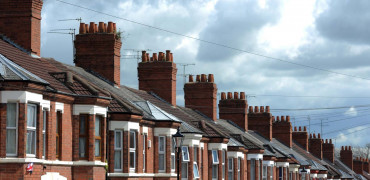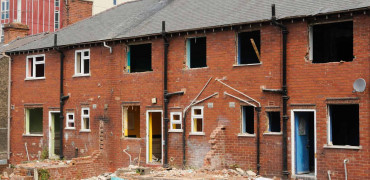For the UK to hit its carbon reduction targets by 2050 (or preferably earlier) it is becoming increasingly obvious that the country needs to up its game over retrofitting our existing housing stock.
There are an estimated 24.8 million dwellings in England, including both occupied and vacant homes.
The people living in these properties use up huge amounts of energy, which equates to roughly 14 per cent of our total carbon emissions as a nation.
Much of this energy use could be reduced if our homes were less draughty, better insulated and had more efficient heating systems installed in them.
It is for this reason that the Government is urging and cajoling the house-building sector to up its performance and construct more low carbon and even zero carbon homes.
The vast majority of us are going to be living in older housing stock for decades
A numbers game
But no matter how well the housebuilders do on this score, the maths are against them having the sort of impact we would all like them to have in the next 10, 20 or 30 years.
New homes are currently being built at a rate of about 220,000 to 235,000 a year and it’s now being forecast that we will not meet the Government’s target of 300,000 new homes a year until maybe 2028, rather than 2025 as originally predicted.
So we are only adding about one per cent of new houses to the country’s housing stock each year.
This means the vast majority of us are going to be living in the existing (older) housing stock for many decades to come.
If we are serious about reducing our carbon footprint then the only realistic option is to retrofit low carbon use into our current homes. This was the logic behind programmes like the Green Deal, but politicians messed with the details and funding of those and they failed to deliver on their potential.
Mainstreaming retrofitting
We need to re-establish retrofitting and make it mainstream. Personally I’m seeing more visible signs of efforts to green our transport with electric car battery charging stations popping up all over the place, than I am in the greening of our homes.
However, there are some grounds for optimism as the nation’s homes are getting better in terms of their energy efficiency, but progress has stalled to a degree in recent years and it needs a kickstart.
A particular challenge will be how private sector landlords can be motivated and encouraged to improve their rental stock. The work involved can be costly (paid for up front with slow rates of return) on them financially, as well as disruptive to any occupiers. This could make properties uninhabitable for short periods, resulting in a loss of rental income.
A stalled programme
In 2019, 86 per cent of homes in England had full double glazing, up from 73 per cent of homes in 2009. Half (50 per cent) had cavity or solid wall insulation (up from 39 per cent in 2009) and 39 per cent had 200mm or more of loft insulation (up from 24 per cent in 2009).
Also in 2019, the average SAP rating of English dwellings was 65 points, up from 45 points in 1996. This longer-term upward trend was evident across all tenures, but it’s clear more work needs to be done in improving energy efficiency within the private sector.
The social housing stock has an average SAP rating of 69, whereas the private sector stock has an average SAP rating of 64. The social sector was more energy efficient than the private sector, in part due to wider use of solid wall insulation, but also because of dwelling type and the age of its properties, as well as long-term investment by councils and housing associations.
In addition, the social housing sector contains a higher proportion of flats compared to the private sector, so in general its properties have less exposed surface areas (external walls and roofs) through which heat can be lost, than detached or semi-detached houses in the private sectors.
Insulation and heating upgrades
The increase in wall insulation across the stock was mostly driven by an increase in the prevalence of insulated cavity walls. Taking dwellings with predominantly cavity or solid walls separately, 68 per cent of dwellings with predominantly cavity walls had insulation installed compared with only 11 per cent of dwellings with predominantly solid walls.
Among dwellings with solid walls, the social rented sector had a higher proportion with solid wall insulation (28 per cent) than the private sector (8 per cent).
Among dwellings with cavity walls, the private rented sector had a lower proportion of dwellings with cavity insulation (56 per cent) than the other tenures (for example, 70 per cent of owner occupied dwellings and 72 per cent of social rented sector dwellings).
Older, less energy efficient boiler types are also more prevalent in the private sector. There has been a huge increase in the use of condensing and combi boilers since the turn of the century. In 2019, 13 per cent of owner occupied dwellings and 9 per cent of private rented dwellings still had an old standard boiler, compared with just 3 per cent of social sector dwellings.
Final words
These figures provide a compelling case for establishing a properly resourced and Government-backed programme of property improvements to help meet the carbon use reduction targets.
But because of previous high profile problems over set-up and implementation, the building and maintenance sector needs the confidence that all major political parties are signed up to delivering such a programme and that recruitment, training and supply issues are being addressed.
The re-training of gas engineers so they are equipped to instal and maintain heat pumps is a case in point. If the country is to meet a target of 600,000 new heat pump installations a year by 2028, it needs a workforce that can deliver this.
The Heat Pump Association has set up a training scheme to deliver this, but much more needs to be done to ensure supply chains are robust enough to cater for this level of demand.
But if the 99 per cent of the housing stock is to catch-up with the 1 per cent of new low carbon homes, then other than boosting the retrofitting business, I really am not sure what the answer is.
Patrick Mooney is editor of Housing Management and Maintenance magazine



